How To Find Seashells On The Beach
*This article may contain affiliate links. We receive a pocket-sized commission at no extra cost to yous. If you bask our content and want to support Travel For Wildlife, please visit our shop Truly Wild.
If yous love collecting ocean shells then you probably too accept a fondness for nature and wild animals. The two seem to go mitt in hand. So when y'all crouch downwards to the sand with that saucepan in your manus you lot might occasionally ask yourself, "Is in that location whatsoever reason I shouldn't collect this seashell?" That question is exactly what inspired me to create this guide to ethical beat collecting.
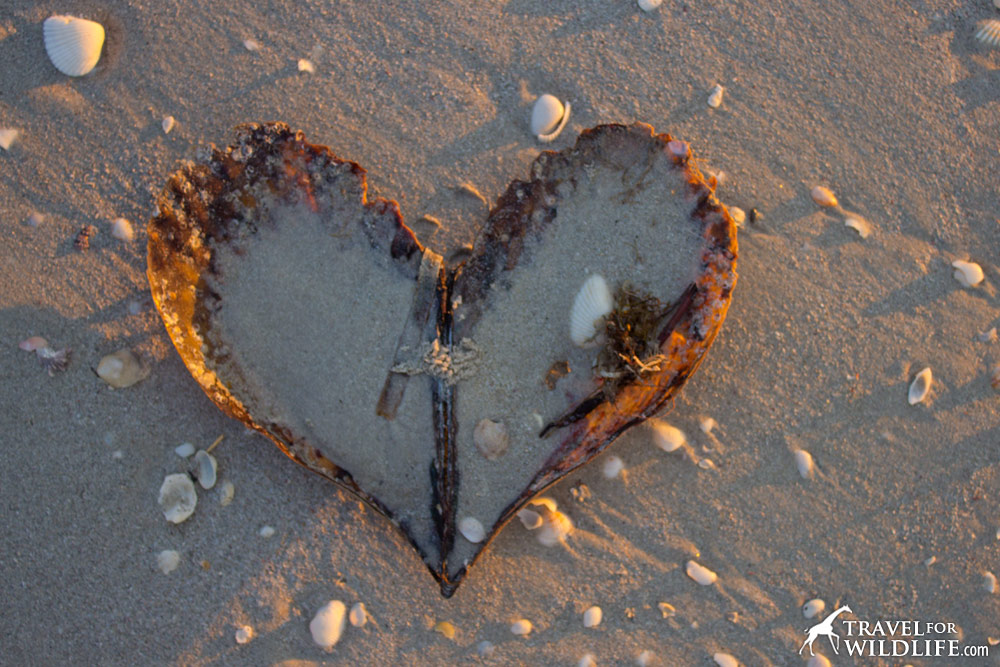
Do you love shelling? Do yous dearest wild animals? Then yous'll beloved this guide to ethical beat out collecting!
To assist reply this question, I joined forces with the most experienced sheller I know: my mom. The bumper sticker on the dorsum of my mom's minivan reads GO TO SHELL. Beneath it is printed the name of what many consider the all-time shelling embankment in the world: Sanibel Isle, Florida.
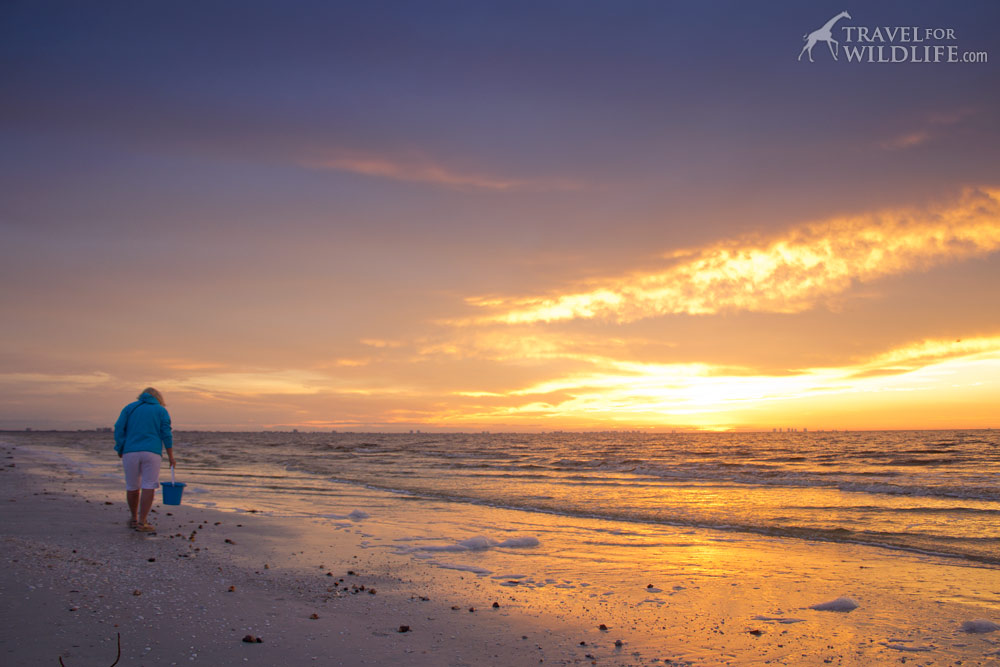
My mom doing what she loves, crush collecting in Sanibel Island, Florida, Usa
She could probably spend the residuum of her life strolling the beach and looking for the most beautiful specimen of each and every vanquish species. And she's not alone. Thousands of shellers pack the beaches of Sanibel each year, searching for their own treasures. And Sanibel is merely i of many famous shelling beaches around the earth.
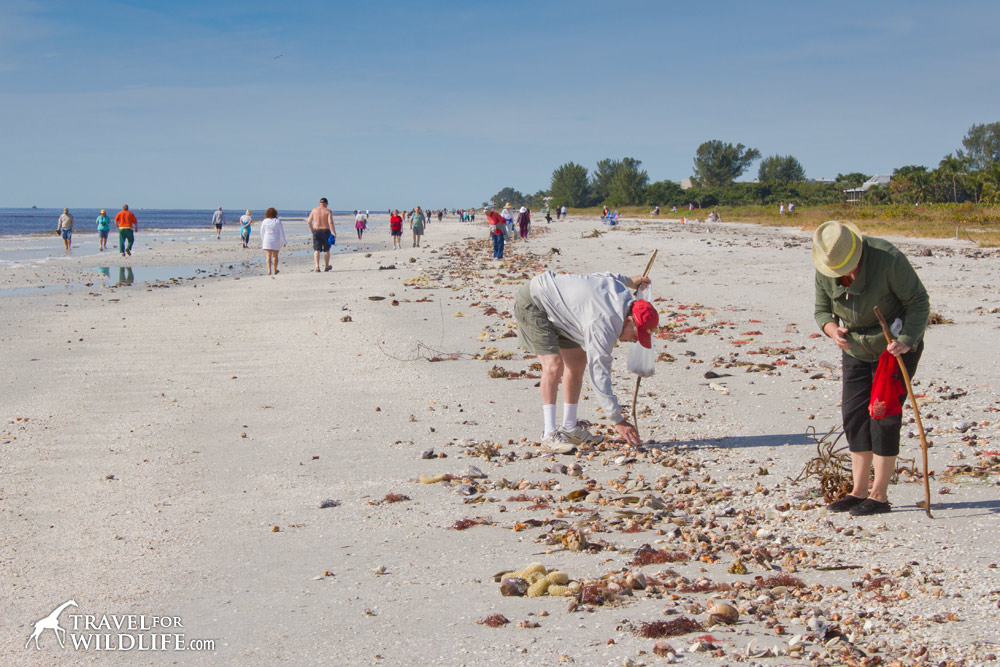
Thousands of shell collectors comb the beaches of Sanibel Island, Florida, United states of america
When I was a kid I collected all sorts of natural mementos, from skulls to stones to feathers, and equally I began to travel more I started grabbing shells from various beaches around the world. But at present that I've grown a chip older my collecting urges have faded. Mostly considering, while visiting wild places, I'g used to being instructed over and over to "take nothing but photos and leave cipher but footprints." At present the idea of walking a embankment and grabbing bucketfuls of animal remains (which of form is what a shell is) makes me cringe a little. Then I decided to spend a week shelling in Sanibel with my mom, learn what it's all about, and come up up with my own guide to eco-friendly shelling.
But I got a niggling more than I bargained for. An unusual combination of forces, including a huge storm and a red tide event, washed upwardly millions of creatures onto the beach, both living and dead. It was unlike anything I had always seen. I finally had a chance to come across the living animals backside the shells.
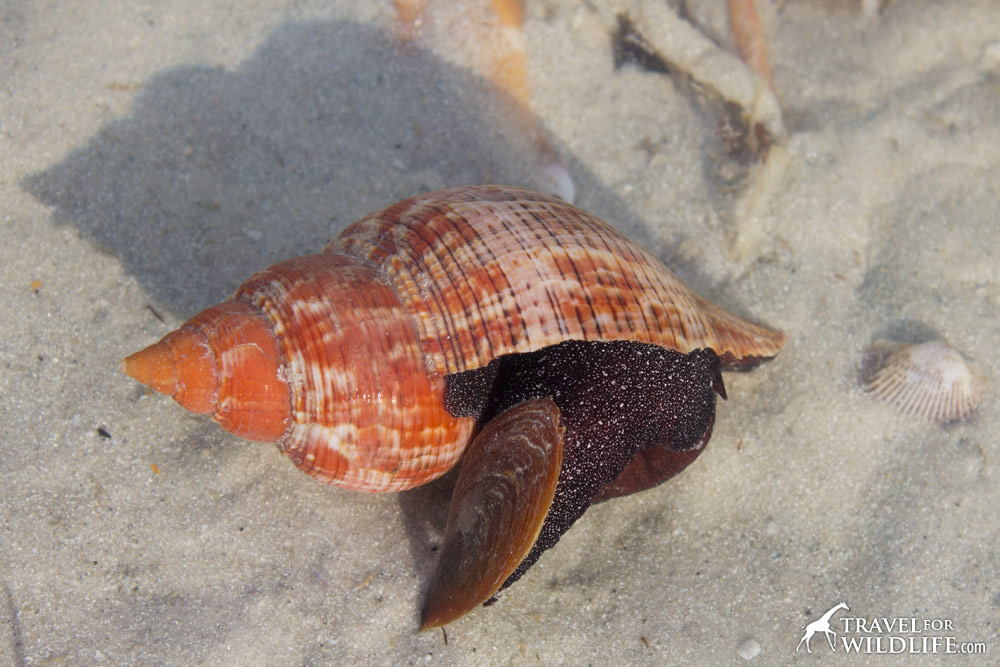
A living "True Tulip" beat and its beautiful inhabitant, colored like a heaven full of stars, in a tide pool on the beach in Sanibel.
It was both fascinating and centre-wrenching to encounter. Long tidal pools had formed in depressions on the beach where all sorts of rarely-seen creatures were moving virtually as if they were still on the bottom of the body of water. But many more were stranded high and dry out on the sand, waving their mysterious anatomies and hoping for the tide to return before long. So it was with a peculiar mix of joy and sorrow that I began to explore the living shells of Sanibel Island. Information technology gave me a new-establish appreciation for the charismatic little creatures that create all these shells and depend upon them for their homes.
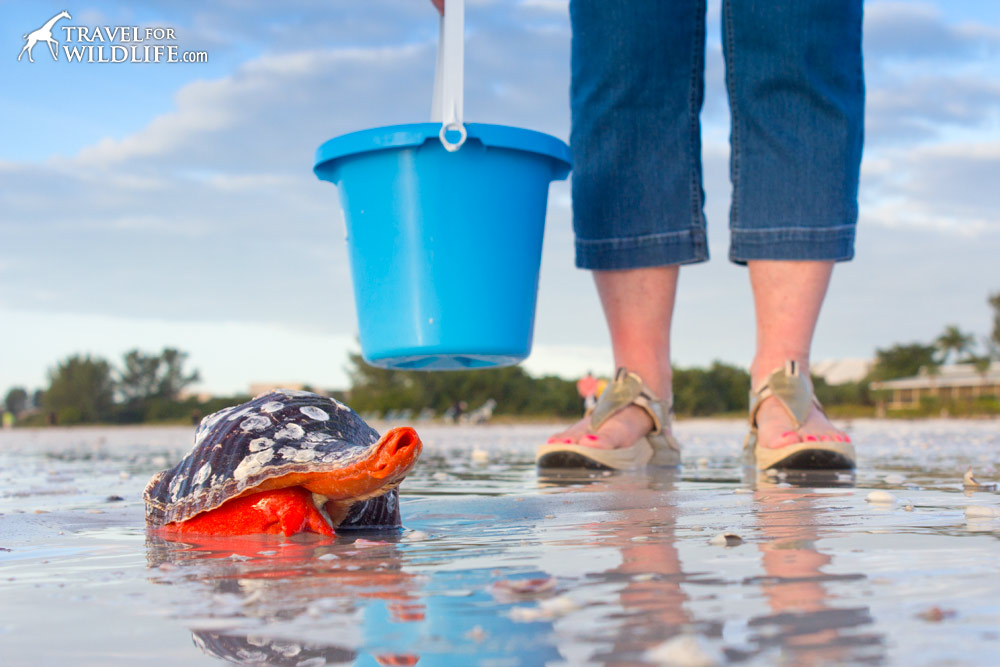
A living Equus caballus Conch contemplates her render to the bounding main as the tide returns.
A Guide To Ethical Beat Collecting
I've formatted this guide as a list of tips for responsible seashell collecting practices, organized from basic to avant-garde.
BEGINNER (Outset Here)
1) Don't take anything that is alive
WHY: This may seem similar an obvious one, but these animals are individuals just similar yous and me, trying to live there lives.
The thought of killing an animal merely to display some of its body parts (much similar trophy hunting) may audio icky, simply many folks are willing to do only that to have a shell, a sand dollar, or a starfish on their shelf. It's not merely immoral, it isillegal in Sanibel and Lee County (according to the laws about recreational sea shell harvesting in Florida) to "harvest or possess any shells that incorporate a live organism except for oysters, hard clams (quahogs), sunray venus clams and coquinas."
If for some reason you're on the fence almost this 1 and wondering what'south the large deal about killing a body of water snail, so take a wait into the optics of this Florida Fighting Conch and ask yourself if you really need this beat more than she does.
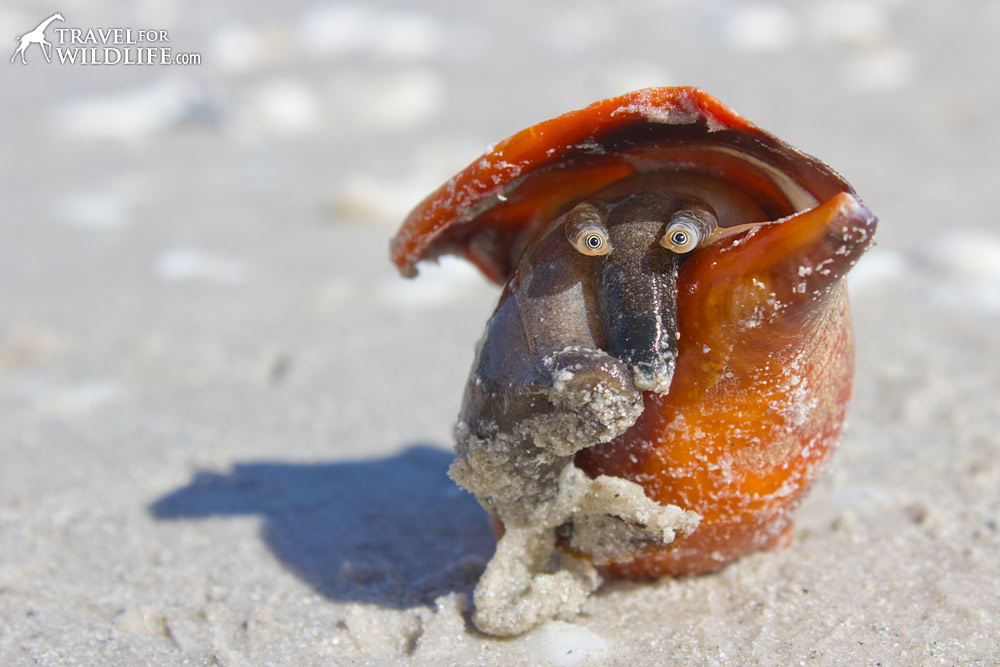
Looking into the eyes of a Florida Fighting Conch stranded on the beach later a storm in Sanibel.
If you need aid figuring out what is alive and what is dead, see our article How To Figure Out if a Sand Dollar, Starfish, Egg Case, Urchin, or Sea Beat is Live or Dead.
Tip: If you practise find a alive creature stranded on the sand, whatever it may be (a trounce, an egg case, a starfish, a crab, an urchin, or a sea cucumber) feel gratis to pick it up gently with your manus (if information technology can't harm you) or a bucket and return it gently into the sea as deep as you can walk. Please don't throw it similar a baseball! The odds of these animals surviving in the baking sun are quite low unless the next tide shortly returns them to the body of water. Aye, they may wash upward once more, simply by returning them to the bounding main you are at least giving them a chance.
A note near shell shops.
About every specimen for sale in a shell shop or souvenir store comes from a living animal that was killed for the sole purpose of making a souvenir. That'due south why they are in such perfect status. Some are caught unintentionally every bit "bycatch" from the commercial line-fishing manufacture and others are intentionally harvested. If you wouldn't kill a living animal on the beach for your collection, then yous shouldn't purchase 1 at a shell shop either.
INTERMEDIATE (You're Getting Skilful at This)
ii) Leave Screw Shells
WHY: Hermit crabs depend on empty spiral shells of all sizes for their survival.
Certain, spiral shells are some of the near cute shells y'all can find. But in that location is some other collector out there who needs them even more than you practise: the hermit crab.
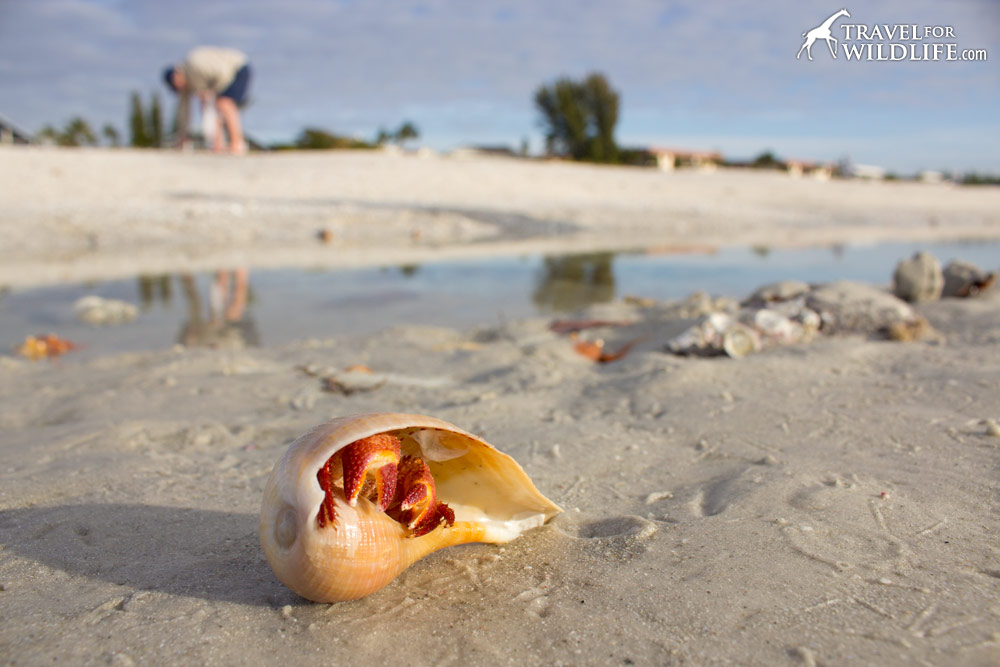
A hermit crab peeks out of a Fig shell that whatever collector would be proud to have.
There are more than a thousand species of hermit crabs worldwide, and each one of them depends on empty body of water shells for survival. Of course you wouldn't take a spiral shell that already had a living hermit crab in information technology, only by taking empty spiral shells from the embankment you are depriving those same hermit crabs of their next domicile. Equally hermit crabs grow, they must motion into ever larger shells. If a hermit crab can't find a larger shell, information technology will die of exposure or predation.
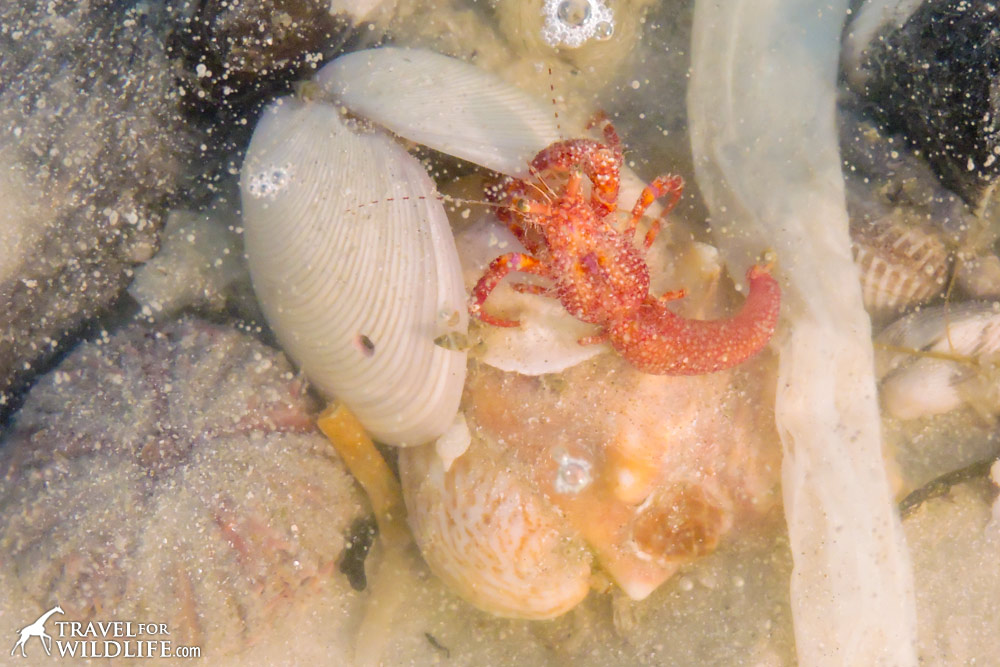
This living hermit crab in a tide puddle on Sanibel is searching desperately for the right sized trounce to move into before a bird grabs him!
Here'south an astonishing segment from a BBC program showing how difficult it can be for hermit crabs to discover a crush of just the right size.
During our week in Sanibel nosotros plant screw shells of every size containing hermit crabs, from microscopic to gigantic and everything in between.
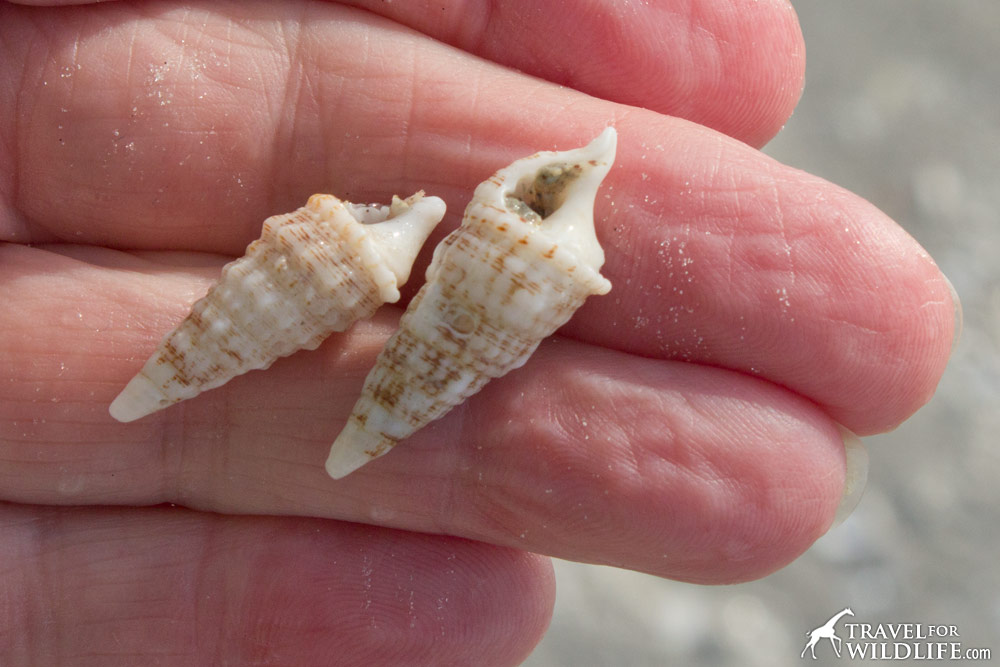
Hermit venereal need tiny spiral shells too! Each of these Cerith Shells has a tiny hermit crab inside of information technology.
We also plant a huge dead hermit crab who probably couldn't notice a large enough empty shell to motility into. The only shell that could fit this guy would exist a large horse conch and these are especially difficult to find considering collectors snatch them all up!
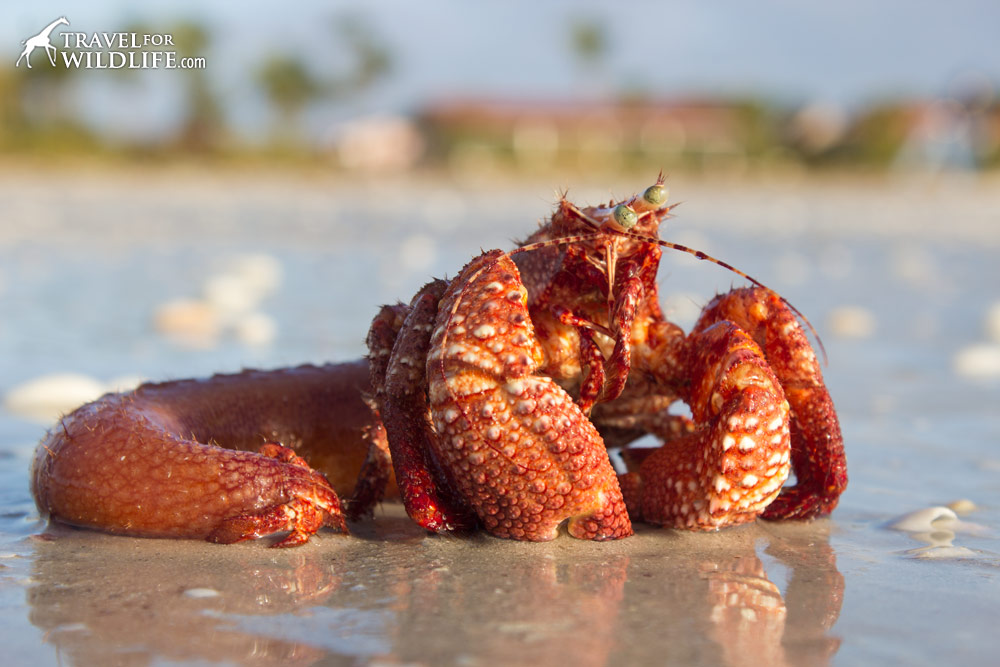
Behemothic red hermit crab with no shell, found dead on the embankment in Sanibel.
If you feel you just have to take a certain spiral shell for your collection, please only take one and leave the residue for someone who actually needs it!
ADVANCED (You're a Champion for Wild fauna and Biodiversity!)
3) Have Less, or Better However, Take Only Photos
WHY: A wide diverseness of plants and animals depend on expressionless shells for their survival.
All shells play a role in natural ecosystems. If someone walked by your yard everyday and collected a scattering of dirt, saying to themselves "they don't need this dirt, what damage will 1 handful practice?" you might be a chip irritated. If a hundred people did it every day, you might start to discover some effects in your ain ecosystem, like your grass is gone and your firm is eroding into a hole. The same is true for shells on beaches.
One scientific study on shell collecting shows that increased tourism is directly correlated to a reduction in the number of shells found on a beach. This may accept a string of consequences on natural processes including, co-ordinate to the written report, "increased beach erosion, changes in calcium carbonate recycling, and declines in diverseness and affluence of organisms, which are dependent on shell availability."
In another role of the earth, in Mauritius, information technology has been estimated that threescore% of the shells take disappeared. This is due to tourists taking a fleck of Mauritius home.
Hither are some of the more than obvious examples of how the healthy presence of shells benefits animals, plants, and ecosystems:
1) Bounding main grasses, corals, and anemones often use shells to ballast to the ocean floor.
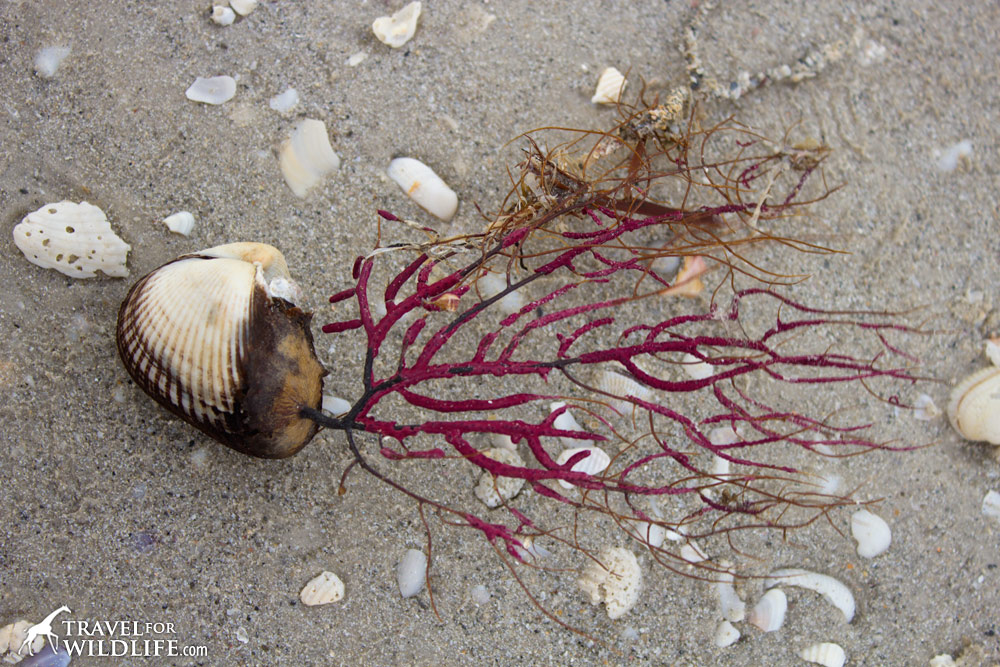
Corals and grasses apply shells as anchor points. Here a "sea whip" (a blazon of coral) is anchored to a Ponderous Ark shell.
2) Many creatures like to brand their homes on height of dead shells, like slipper shells, barnacles, limpets, and chitons.
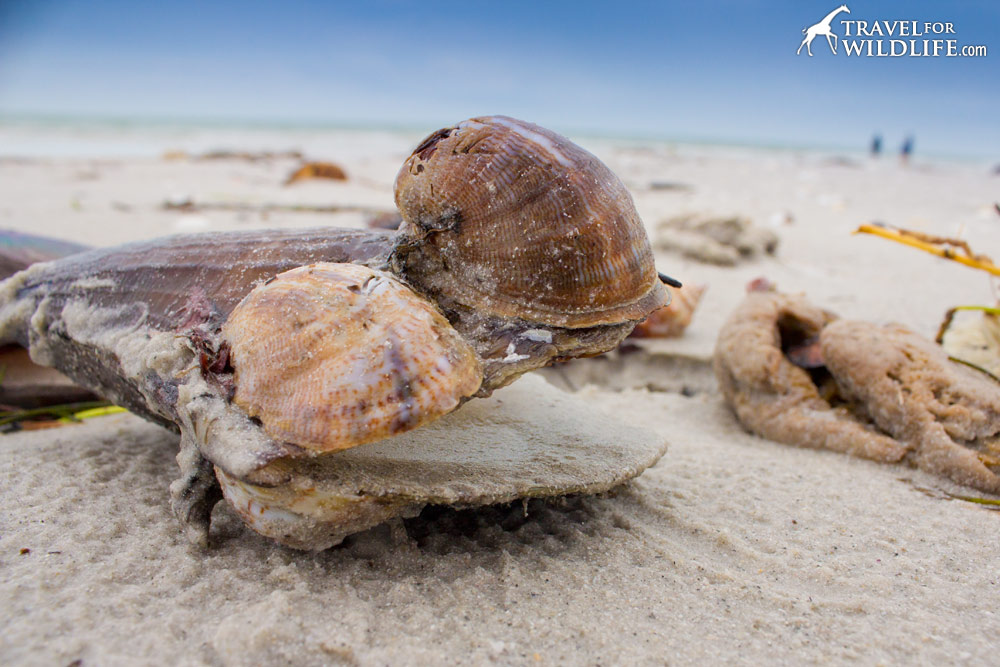
Many living shells, like these Slipper Shells, make their homes upon expressionless shells similar this Pen shell.
three) Some creatures use dead shells to cover-up themselves like sea urchins and the astonishing Carrier Shells (called Xenophoridae).
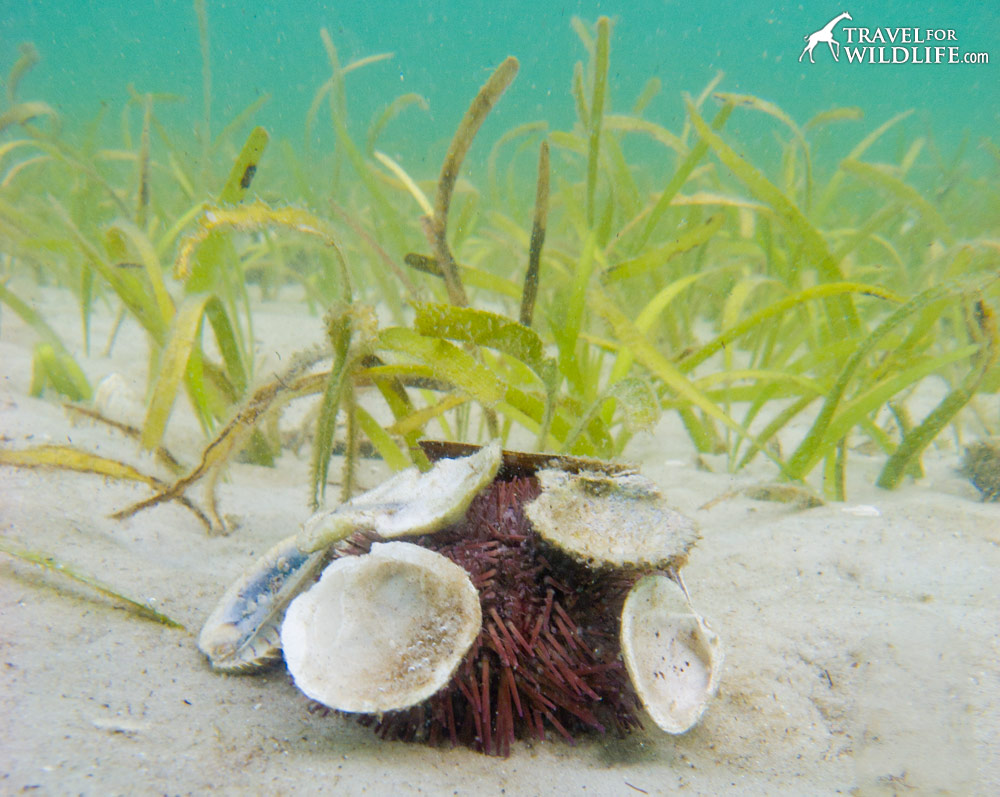
Some animals, like this sea urchin, wear discarded body of water shells as camouflage .
iv) Small fish and octopus employ discarded shells for cover and shelter. Hither's a peachy video of a pocket-size octopus who couldn't find a shell for protection and had to use a plastic cup instead (until defined constitute another shells for him to try).
5) Other organisms couch into dead shells to survive, including endolithic algae and sponges.
6) Pieces of quondam shells are used as edifice materials by a diverseness of terrestrial animals. For example, the threatened beach-nesting bird, the Piping Plover, uses shells to line its nest. The male Pipe Plover is the 1 who constructs the nest scrape then lines it with seashells. (Photo by Amanda Pachomski, Long Island Bird Conservation Manager at Audubon New York, Be a Good Egg NJ NY)
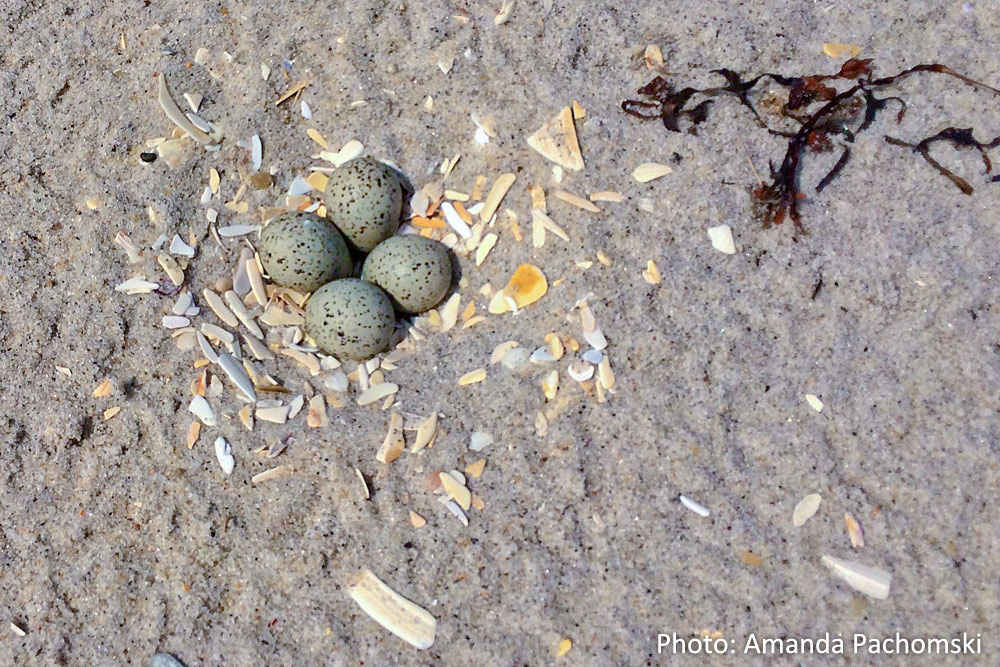
The endangered pipage plover uses sea shells to line their nest.
vii) Various marine animals apply shells as a building textile as well. Some marine worms (pictured below) use bits of shell to construct the protective tubes in which they live.
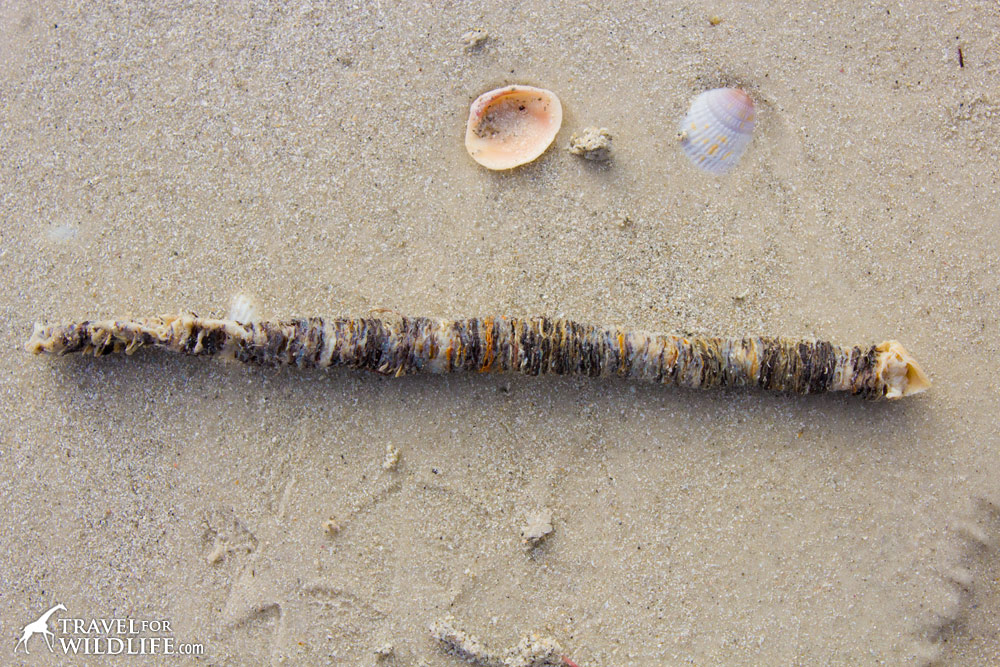
Some marine worms, like this one, utilise pieces of beat out to build their protective tube.
8) Birds, crabs, and many other organisms depend on the remains of washed-up sea creatures for food.
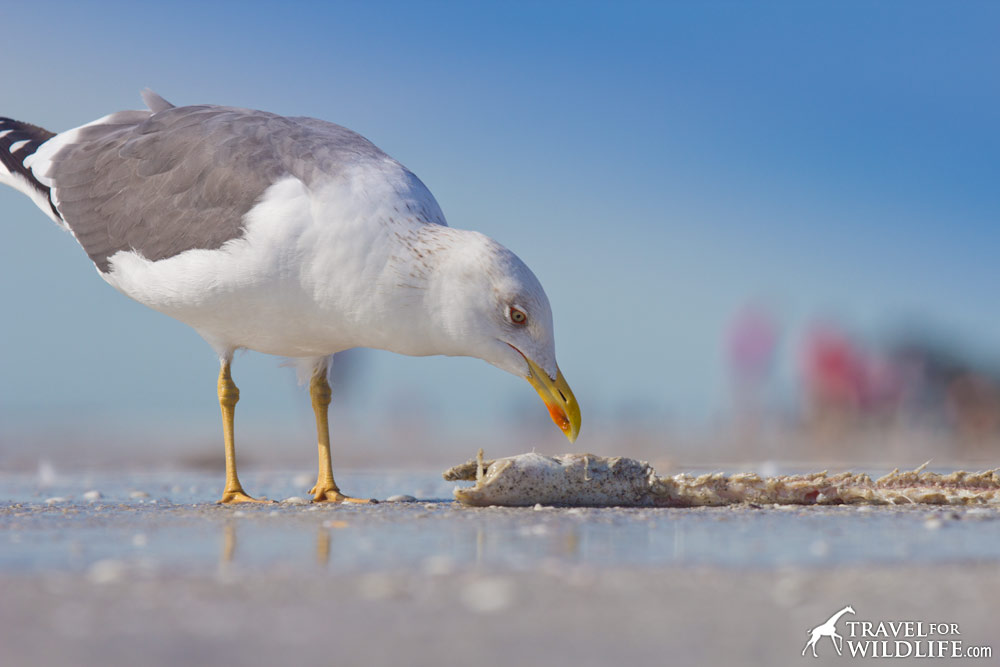
Many birds and crabs depend on dead shells and other remains for food.
Remember, an empty trounce washed up from a storm today may cease upwardly as an empty shell back in the ocean tomorrow where thousands of creatures rely on it for survival.
And then is there a danger that humans are going to take every beat from the beach? Of course non. Volition one person taking a handful of shells kill a hermit crab and an endangered bird? Nope. Merely our cumulative bear upon continues to grow every bit our population expands and more than and more visitors appear on our beaches. Think about where your shells are going to finish upwards and ask yourself if they're doing the globe more than skillful in a purse on your shelf or out in the natural ecosystem where they came from. Shell collecting tin still give you great happiness, even without removing thousands of them from their natural habitat!
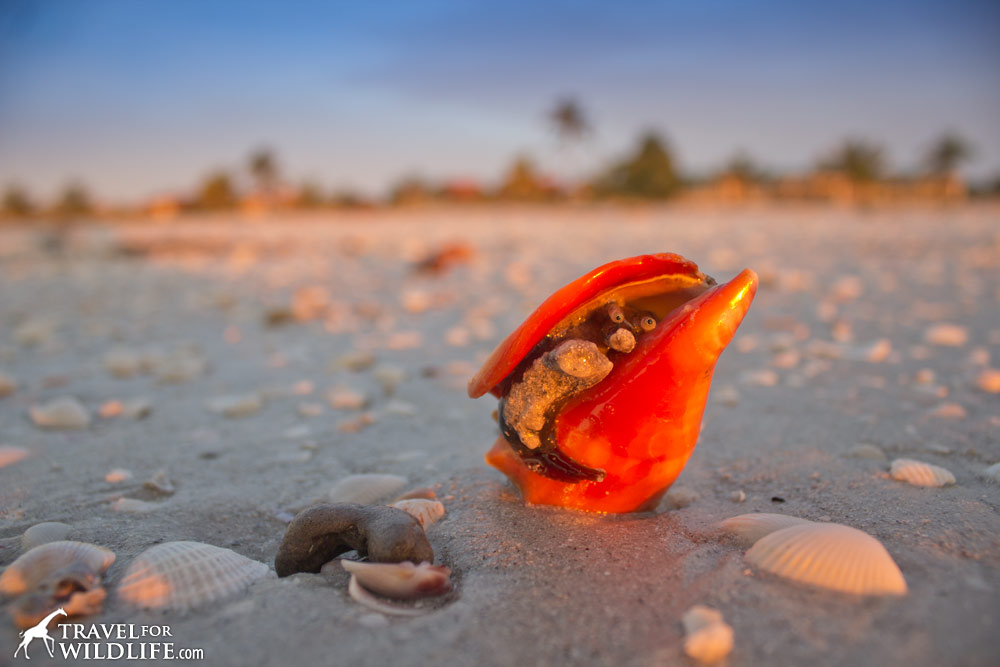
Shells play an of import office in coastal ecosystems! Here a Florida Fighting Conch watches the sunrise and waits for the tide.
I admit I felt the urge to possess some of the beautiful shells I saw. But then I realized I had some other fashion to collect shells right in my hand: a photographic camera. I thought to myself,Why not showtime a photo collection of all the best trounce specimens that yous discover on the embankment? And so it can exist shared online for the whole world to enjoy and larn from, while the shells even so get to fulfill their natural role! Desire to see my cool beat out collection? Check out my Virtual Crush Drove: a Photo Gallery of Living Shells from Sanibel Isle!
Did you find this article helpful? Pin this image!
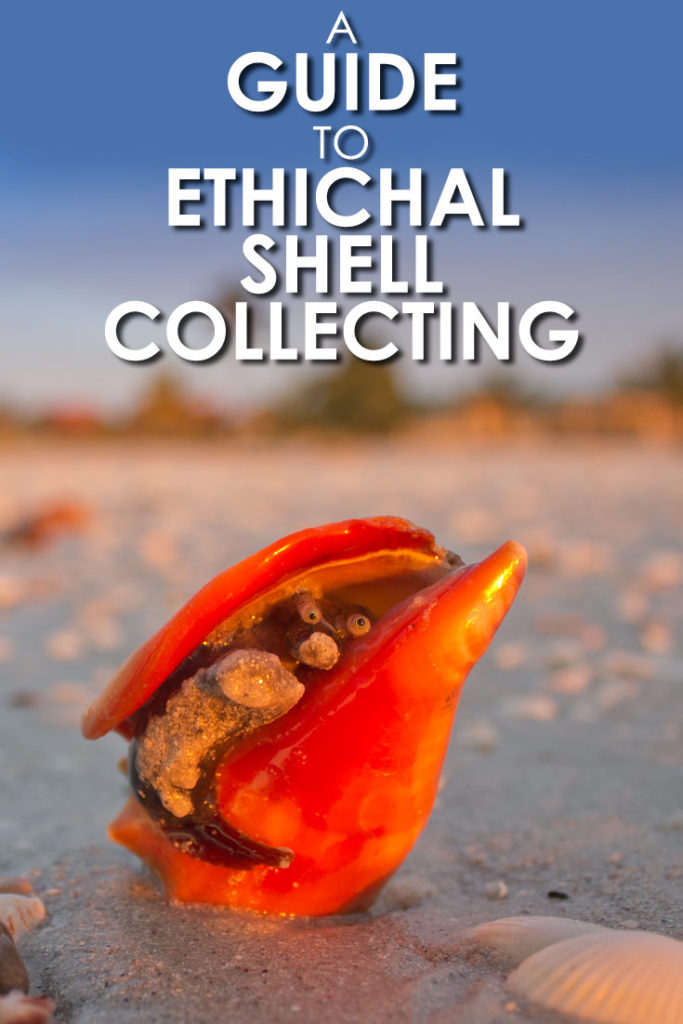
Source: https://www.travel4wildlife.com/ethical-shell-collecting-guide/
Posted by: devinemarisch.blogspot.com


0 Response to "How To Find Seashells On The Beach"
Post a Comment